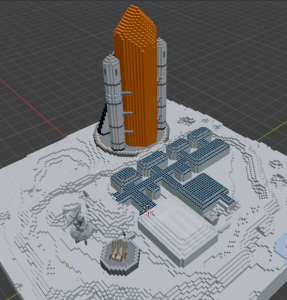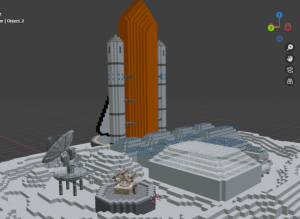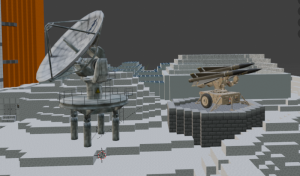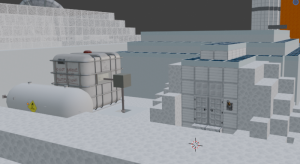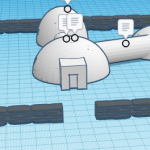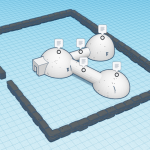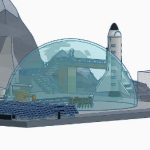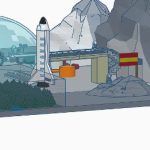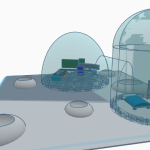Mondstation DPB by Einstein Lunar Explorer 5
Albert-Einstein-Gymnasium Berlin-Neukölln Germany 16 years old 5 / 0 German Moon
Project description
Unsere Mondstation heißt “DPB”. Das Hauptziel der Mondstation ist die Gewinnung von Helium-3. Damit soll die Kernfusion auf der Erde ermöglicht werden, da es auf der Erde kaum Helium-3
gibt. Es aber ein essenzieller Bestandteil ist, um Kernfusion als Hauptenergiequelle auf der Erde zu nutzen. Unsere Mondstation besteht aus einem Hauptgebäude, in dem sich Kontrollräume mit den gesamten Geräten befinden. Auf den Monitoren werden die aktuellen Sauerstoffwerte der Luft zur Kontrolle angezeigt und weitere generelle Informationen, die wichtig für das Funktionieren der Mondbasis und das Überleben der Astronauten sind. Des Weiteren befinden sich im Hauptgebäude die Schlafräume für die Astronauten sowie das Fitnessstudio. Darüber hinaus gibt es Büros für die Astronauten und eine Glaskuppel, wo Nahrung angebaut wird. Außerdem sind Speicher für Helium-3 vorhanden. Damit das Helium-3 auf die Erde transportiert werden kann, gibt es eine Raketenabschussstation mit einer Rakete. Unsere Mondbasis liegt in der Nähe des Südpols, da es dort hohe Vorkommen von Helium-3 gibt. Außerdem ist am Südpol das für die Elektrolyse benötigte Eis vorhanden.
Um die Versorgung der Mondstation mit Energie zu garantieren, gibt es auf unserer Mondstation einen Fusionsreaktor. Wir haben uns für Kernfusion entschieden, da Kernfusion aus wenigen Materialien viel Energie erzeugt. Außerdem ist Kernfusion im Gegensatz zu anderen Energiequellen wie Solarenergie nicht abhängig von äußeren Faktoren, wie zum Beispiel Sonne zur Stromerzeugung. Ein weiterer Vorteil von Kernfusion ist, dass der zweite Stoff (Wasserstoff), der für die Kernfusion benötigt wird, ebenfalls auf dem Mond vorhanden ist. Wasserstoff kann durch Elektrolyse, also der Zerlegung von Wasser in Sauerstoff und Wasserstoff, durch einen elektrischen Strom separiert werden. Das benötigte Wasser kann aus den Eisvorkommen an den Polen des Mondes gewonnen werden. Da wir uns den Gefahren, die ein möglicher Ausfall des Fusionsreaktors darstellt, bewusst sind, haben wir uns dazu entschieden, eine Notfallenergiequelle zu bauen. Als beste Notfallenergiequelle sehen wir Solarenergie. Allerdings muss es große Energiespeicher für die erzeugte Solarenergie geben, da der Mond sich nur einmal pro Monat um seine eigene Achse dreht und somit eine Mondnacht 2 Wochen lang ist. Die Notfallenergiespeicher müssten also in der Lage sein, die Mondstation 2 Wochen lang mit Energie zu versorgen, da danach der Mondtag beginnt und somit wieder neue Solarenergie erzeugt werden kann. Der Grund, warum wir uns trotz dieses Nachteiles für Solarenergie als Notfallenergiequelle entschieden haben, ist das die Bedingungen auf dem Mond für Solarenergie sehr gut sind. Einerseits hat der Mond keine Atmosphäre, andererseits gibt es keine Luftverschmutzung oder Wolken, die die Sonnenstrahlen blockieren könnten. Aus diesen Gründen könnte während des Mondtages extrem viel Energie erzeugt werden, die, wenn sie gespeichert wird, die optimale Notfallenergiequelle ist. Ein Problem der Solarenergie auf dem Mond ist das Mondregolith, eine Schicht aus Staub und Kies, welche sich auf den Solarpanels ansammelt und somit die Leistungsfähigkeit der Solarpanels beeinträchtigt. Darum hat unsere Mondstation mehrere Saugroboter, welche mehrmals täglich die Solarpanels vom Mondregolith befreien. Der aus der Elektrolyse resultierende Sauerstoff kann zur Erzeugung von Luft benutzt werden. Dafür muss mithilfe eines Carbon Dioxide Removal Assembly (CDRA) Kohlendioxid aus der Luft entfernt werden. Darüber hinaus wird die Luft kontinuierlich durch Luftfilter gereinigt, um Schwebeteilchen und Verunreinigungen zu entfernen. Alle diese Systeme werden bereits auf der ISS verwendet und funktionieren dort optimal.
[…weitere Infos in pdf und in 3D-Modell in Blender-Datei]
Project link
https://drive.google.com/open?id=1mbDVzgKdcYe0GMqLvYFKJjLVrLX9d4f5&usp=drive_fs
English translation
Our lunar station is called “DPB”. The main goal of the lunar station is to extract helium-3. This is intended to enable nuclear fusion on Earth, as there is hardly any helium-3 on Earth.
But it is an essential component for using nuclear fusion as the main energy source on Earth. Our lunar station consists of a main building in which control rooms with all the equipment are located. The monitors display the current oxygen levels in the air for control purposes and other general information that is important for the functioning of the lunar base and the survival of the astronauts. The main building also contains the sleeping quarters for the astronauts and the gym. There are also offices for the astronauts and a glass dome where food is grown. There is also storage for helium-3. There is a rocket launch station with a rocket so that the helium-3 can be transported to Earth. Our lunar base is located near the South Pole, as there are high deposits of helium-3 there. The ice required for electrolysis is also available at the South Pole.
To guarantee the supply of energy to the lunar station, there is a fusion reactor on our lunar station. We chose nuclear fusion because nuclear fusion generates a lot of energy from just a few materials. Furthermore, unlike other energy sources such as solar energy, nuclear fusion is not dependent on external factors, such as the sun generating electricity. Another advantage of nuclear fusion is that the second substance (hydrogen) required for nuclear fusion is also present on the moon. Hydrogen can be separated by electrolysis, i.e. the decomposition of water into oxygen and hydrogen, using an electric current. The water required can be obtained from the ice deposits at the poles of the moon. Since we are aware of the dangers posed by a possible failure of the fusion reactor, we decided to build an emergency energy source. We see solar energy as the best emergency energy source. However, there must be large energy storage facilities for the solar energy generated, since the moon only rotates on its own axis once a month, making a lunar night two weeks long. The emergency energy storage units would therefore have to be able to supply the lunar station with energy for 2 weeks, because after that the lunar day begins and new solar energy can be generated again. The reason why we chose solar energy as an emergency energy source despite this disadvantage is that the conditions on the moon are very good for solar energy. On the one hand, the moon has no atmosphere, and on the other hand, there is no air pollution or clouds that could block the sun’s rays. For these reasons, an extremely large amount of energy could be generated during the lunar day, which, if stored, is the optimal emergency energy source. One problem with solar energy on the moon is the lunar regolith, a layer of dust and gravel that accumulates on the solar panels and thus impairs the performance of the solar panels. That is why our lunar station has several vacuum robots that clean the solar panels of the lunar regolith several times a day. The oxygen resulting from the electrolysis can be used to generate air. To do this, carbon dioxide must be removed from the air using a Carbon Dioxide Removal Assembly (CDRA). In addition, the air is continuously cleaned by air filters to remove suspended particles and contaminants. All of these systems are already used on the ISS and work perfectly there.
[…more information in pdf and in 3D model in Blender file]
#3D Design
Other Projects
Sainte Foy la Grande – France



